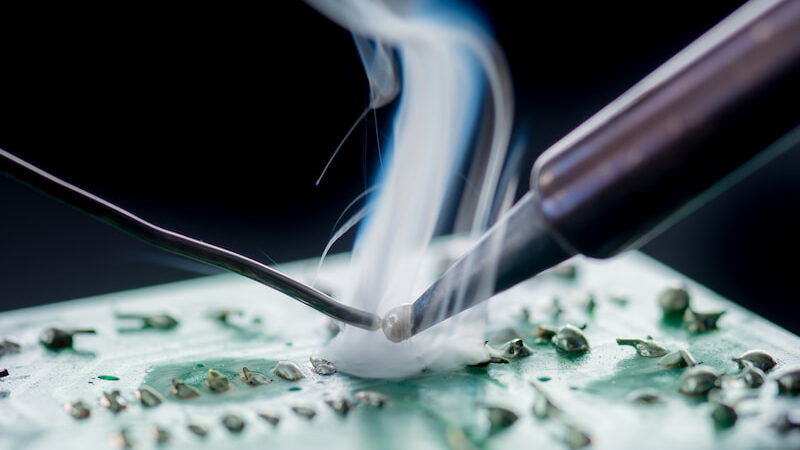Is the smoke from soldering iron bad for health? (2023)
Soldering is a fundamental process in electronics and other industries where two or more metal components are joined together using a soldering iron. During soldering, it provides harmful smoke which consists of different gases.
Yes, the solder fume can raise concerns about its potential impact on human health. The smoke or fume is released when hot iron comes in contact with filler material called solder and flux. Flux is a chemical compound which removes oxidation from joints and improves the molten solder flow.
If you inhale toxic smoke it causes respiratory issues, eye and skin irritation, nausea and headaches, and long-term health risks. Long-term exposure to smoke also causes vision loss. Adopting safety precautions such as working in a well-ventilated area, using a smoke extractor, wearing personal protective equipment (PPE) and taking a short break from the soldering process from time to time can minimize the risk of smoke exposure.
In this blog, we will explore the dangers associated with soldering iron smoke and provide practical tips to minimize exposure and protect your health.
Let’s get started.
Is the smoke from soldering iron bad for health?
Soldering seems fun, but when we don’t proper safety measure it can lead to bad health concerns.
First let’s see what is solder smoke, what health issues it can cause, and most importantly how we can protect ourselves from this.
Solder smoke
Soldering smoke, also known as soldering fumes or soldering vapor, is the airborne mixture of gases, vapors, and particles released during the soldering process.
Flux is applied to the surface to be soldered before soldering. When hot iron comes in contact with solder and the joint to be solder, the phase change occurs and flux, solder and hot iron release solder smoke which is toxic.

The soldering fume is hazardous because it contains potentially harmful gases that can harm a person’s health. Along with CO2, O3, and CH4, CO is the most prevalent gas in the smoke.
Soldering smoke typically contains:
Vapors from Flux: Flux is used in soldering to clean the surfaces of the components and prevent oxidation during the soldering process. When heated, flux releases volatile organic compounds (VOCs) as vapors, which contribute to the composition of soldering smoke.
Metal Particles: Solder itself is a metal alloy that contains various elements such as tin, lead (in traditional formulations), and other metals. As the solder melts and forms the joint, tiny metal particles can become airborne and be present in the smoke.
Oxides: When metals are exposed to heat, they can undergo oxidation, forming metal oxides. These oxides can become part of the soldering smoke.
Residues: Depending on the cleanliness of the components being soldered, there might be residues of other materials such as dirt, dust, or contaminants present on the surfaces. When these materials are exposed to heat, they can contribute to the composition of the smoke.
Health risks due to solder smoke
Let’s discuss the potential health risk due to solder smoke.
1. Respiratory issues
During soldering, when you inhale solder smoke it can irritate the respiratory system. The symptoms lead to coughing, wheezing, and shortness of breath.
Prolonged exposure to these fumes may exacerbate pre-existing respiratory conditions such as asthma or bronchitis.
2. Eye and skin irritation
Exposure to solder fume can cause eye and nose problems. Soldering smoke can irritate the eyes and, in some people, might cause dryness, redness, or rashes on the skin.
3. Nausea and headaches
Solder smoke also triggers nausea and headaches. When you inhale the toxic fume of solder during the soldering process for a prolonged time you may feel headaches. Try to work in a well-ventilated area and wear personal protective equipment.
4. Long-term health risk
Prolonged exposure to fume may cause long-term health risks. Chronic exposure to soldering iron smoke, particularly in work environments, may raise the risk of respiratory problems, lung conditions, and some cancers.
Safety measurements
To protect yourself from harmful fume you should take safety measurements.
Work in a well-ventilated area, this will help you to reduce the inhalation of toxic fume.
- Make use of fume extraction (Amazon link) and these devices help capture and remove the fumes from the air, minimizing your exposure.
- Some fluxes are formulated to produce fewer harmful fumes. Look for “low-halide” or “no-clean” flux options to reduce the release of hazardous substances during soldering.
- Taking a break during soldering tasks allows you to inhale fresh air and give your body a chance to recover from exposure.
- After soldering, wash your hands thoroughly to remove any potential residue from the flux or soldering process.
- Wear personal protective equipment (PPE), such as safety gloves and glasses to protect your skin and eyes from potential irritation.
Conclusion
Soldering is an essential skill in many industries so you need to be well aware of potential health risks associated with soldering. When hot iron touches solder during soldering it releases a cloud of smoke which is considered toxic for human health.
Yes, the solder smoke is bad for health. If it is inhaled regularly respiratory system, the skin can be affected. It also causes nausea, headaches and long-term health risk.
Adopt safety precautions such as working in a well-ventilated area, using a fume extractor, taking a break from soldering from time to time, and wearing personal protective equipment can reduce exposure to solder smoke.
Remember, safeguarding your health while soldering ensures your well-being and contributes to better productivity and overall job satisfaction.
Other useful posts:
